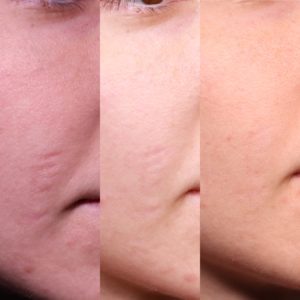What is Subcision?
Subcutaneous incisionless surgery, or subcision, is one of the most effective non-energy-based treatment modalities for acne scarring, particularly rolling scars. In this procedure, a needle or cannula is inserted in between the dermis and fatty layer to sever the fibrotic tethers that cause the dimpled appearance on the skin. You can actually hear the sound of the tethers breaking from underneath!

How can Subcision help me?
For those of you who have undergone one, two, three, or maybe even four subcisions may be wondering why the procedure didn’t work for you. There are several possibilities. Let’s get into a few of them.
First, you might have been a poor candidate for subcision. Patients with predominantly ice pick scars tend to derive little benefit from subcision. Ice pick scars are not tethered to the fatty layer. Instead, their atrophic appearance is caused by complete destruction of the dermis. To treat this, deep chemical peels are needed to regenerate the dermis or punch excisions to remove the scars entirely.
Second, your subcision may have been performed incorrectly. There are a variety of tools available for subcision, not many of which may be robust enough to untether your scars. Subcision was first performed with regular syringe needles until experts decided to implement stronger instruments, such as the Nokor needle and blunt cannulas. Even then, many patients required many costly sessions in order to get the results that they wanted. The invention of the Taylor Liberator, a metal rod with a W-shaped tip, enabled dermatologists to perform “extensive” subcision. This instrument is fitted with a specialized tip that is much more effective at capturing fibrotic tethers as the instrument is advanced through the skin. Not only is this procedure safe, it can also be done from a single entry point near the back of your cheek, as opposed to the hundreds of needle insertions required in conventional subcision approaches.
The best way to maximize the use of Subcision
One thing that all these instruments are missing, however, is how to better homogenize the fatty layer during subcision. When your cystic acne resolves, your dermis and fat can be both significantly damaged. Even if the fibrotic tethers are removed during subcision, the lipoatrophy (fat loss) that remains can still contribute to a dimpled and aged appearance. At SHI, we have invented surgical instruments with specialized tips that redistribute the fat as our tool is inserted to-and-fro through your skin.
If you have had subcision recently, the chances still are that you are healing. It typically takes up to a full year for collagen remodeling to finish course, which means that it could take equally as long to see noticeable changes.
However, if you feel that your subcision simply did not deliver the results you are looking for, it would be wise to review your candidacy for other acne scar removal treatments with your dermatologist. The acne scarring team at SHI is highly trained in pinpointing your acne scar type and depth to determine what treatments are right for you.
Call us to get the soonest available appointment with our team TODAY!
Schedule an Appointment
Scar Healing Institute
Scar Healing Institute is committed to developing the most effective treatments for scarring. Our team of scar revision specialists are continually inventing the latest technologies and formulas to deliver the best results for our patients.

